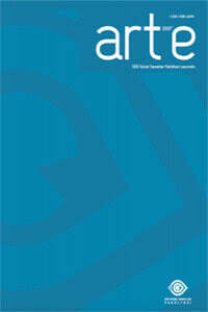Tasarım Nesnesi Olarak Çağdaş Mimarlık Monografileri
Contemporary Architecture Monographs As Design Objects
Architectural Media, Architectural Monograph, Author Visual Image,
___
- Barthes, R. (1977). “The Death of the Author”, Image – Music – Text, der. ve çev. Stephen Heath, Londra: Fontana Press, s. 142-148.
- Benjamin, W. (1970). “Author as Producer”, New Left Review, Sayı 62(1), s. 83-96.
- Betsky, A. (2003). “MVRDV: The Matrix Project”, Reading MVRDV, der. Véronique Patteeuw, Rotterdam: Nai010 Publishers, s. 10-23.
- Colomina, B. (1988). “Introduction: On Architecture, Production and Reproduction”, Architectureproduction, der. Beatriz Colomina, New York, NY: Princeton Architectural Press, s. 6-23.
- Colomina, B. (2008). “Media as Modern Architecture”, Architecture Between Spectacle and Use, der. Anthony Vidler, New Haven, CT: Yale University Press, s. 58-73.
- Croset, P.-A. (1988). “The Narration of Architecture”, Architectureproduction, der. Beatriz Colomina, New York, NY: Princeton Architectural Press, s. 200-211.
- De Bruijn, W. (2006). “Bookscapes: Towards a Conceptualisation of the Architectural Book”, International Journal of the Book, Sayı 3(3), s. 11-24.
- De Smet, C. (2005). Le Corbusier: Architect of Books, Zürih: Lars Müller.
- De Vries, N. (2015). “Foreword”, MVRDV Buildings, der. Ilka Ruby ve Andreas Ruby, Rotterdam: Nai010 Publishers, s. 7.Eerme, L. ve Kinross, R. (2002). “The Architects of the Book”, Domus, Sayı 847, s. 50-79.
- Filler, M. (2011). “Is the Architect’s Monograph Our Latest Endangered Species?”, Architectural Record, Sayı 199(3), s. 31.
- Foster, H. (2004). “Tasarım ve Suç”, Tasarım ve Suç: Müze, Mimarlık, Tasarım, çev. Elçin Gen, İstanbul: İletişim Yayınları, s. 29-44.
- Foucault, M. (1999). Bilginin Arkeolojisi, çev. Veli Urhan, İstanbul: Birey Yayıncılık.
- Foucault, M. (2014). “Yazar Nedir?”, Seçme Yazılar 6: Sonsuza Giden Dil, der. Işık Ergüden ve Tuncay Birkan, çev. Işık Ergüden, İstanbul: Ayrıntı Yayınları, s. 224-259.
- Haferte, K. ve O’Gorman, James F. (der.). (2007). American Architects and Their Books, Boston: University of Massachussetts Press.
- Kubo, M. (2015). “Architecture’s Print Culture”, Journal of Architectural Education, Sayı 69(2), s. 207-211.
- Lamster, M. (2011). “The Architectural Monograph: A Defence”, Places, Sayı 3, https://placesjournal.org/article/ the-architectural-monograph-a-defense/, Erişim tarihi: 10.05.2017.
- Lueder, C. (2015). “Proximity: The Unfolding of a Koolhaasian Hypothesis in Book Space and Architectural Space”, Journal of Architectural Education, Sayı 69(20), s. 187-196.
- Maas, W. (1998). “Datascape”, Farmax: Excursions on Density, der. Winy Maas, Jacob van Rijs ve Richard Koek, Rotterdam: Nai010 Publishers, s. 98-103.
- Maas, W. (2017). Winy Maas ile 26. Dünya Mimarlık Kongresi’nde yapılan görüşme, Seul: 6 Eylül.
- Morris, W. (1982). “The Ideal Book”, The Ideal Book: Essays and Lectures on the Arts of the Book, der. William S. Peterson, Oakland, CA: University of California Press, s. 67-73.
- Ruby, I. ve Ruby, A. (2015). “Introduction”, MVRDV Buildings, der. Ilka Ruby ve Andreas Ruby, Rotterdam: Nai010 Publishers, s. 8-13.
- Szacka, L.-C. (2015). “The Materiality of the Immaterial: S,M,L,XL as Postmodern Manifesto?”, Journal of Architectural Education, Sayı 69(2), s. 163-165.
- Taşçıoğlu, M. (2013). Bir Görsel İletişim Platformu Olarak Kitap, İstanbul: YEM Yayınları.
- Tavares, A. (2016). The Anatomy of the Architectural Book, Zürih: Lars Müller.
- Tsu, V. (2012). “Rendering Tries to Transform Architecture into an Expendable Commodity, Ready For Consumption”, Clog, Sayı 4, s. 106-107.
- Yayın Aralığı: 2
- Başlangıç: 2008
- Yayıncı: Süleyman Demirel Üniversitesi Güzel Sanatlar Fakültesi
Narkissos Mitinin Görsel Sanatlara Yansıması
Mimarlık Kuramlarında Değişen Estetik Yaklaşımları Yeniden Düşünmek
Tarık Emre KIRHALLI, Rifat Gökhan KOÇYİĞİT
Temel Tasarım Eğitiminde Bauhaus Okulu'nun Mekan Üretimine Etkisi
OSMANLI YAZMA ESERLERİNDE MURASSA (MÜCEVHERLİ) KİTAP KAPLARI
Tasarım Nesnesi Olarak Çağdaş Mimarlık Monografileri
Jake ve Dinos Chapman’ın Eserlerinde Yeniden Üretim Ve Francisco Goya İlişkisi
BOZÜYÜK KASIM PAŞA CAMİİ SÜSLEME PROGRAMI
Antik Dönemde Oturma Mobilyasının Öyküsü ve Tarihsel Süreçteki Yansımaları
